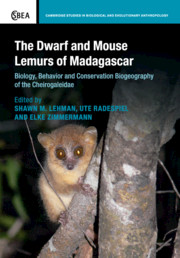 The Dwarf and Mouse Lemurs of Madagascar
The Dwarf and Mouse Lemurs of Madagascar from Part III - Cheirogaleidae: behavior and ecology
Published online by Cambridge University Press: 05 March 2016
Introduction
Hill's (1953, p. 28) multivolume monograph, Primates: Comparative Anatomy and Taxonomy, presented a phylogenetic tree of living primates in which cheirogaleids occupied a position at the base of the Malagasy “lemuroid” radiation, 40–45 Ma if the time scale is read literally. Some years later, Charles-Dominique and Martin (1970) sought to provide evidence to support this view of cheirogaleid archaism. They pooled their expert knowledge of dwarf galagos and mouse lemurs to derive an extensive list of characters shared by the smallest representatives of the Afro-Asian and Malagasy strepsirrhine lineages, which they then interpreted as plesiomorphic retentions from the common strepsirrhine ancestor. The list included small size, nocturnal habit, occupation of a “fine branch and creeper” microhabitat, omnivorous but partly insectivorous diet, use of woven, globular nests and oral transport for the protection of altricial infants, and a “noyau” social system mediated largely by urine washing and other scent marking behaviours. Cartmill (1974) elaborated his model of the adaptive origins of the primate clade and its diagnostic characters (forward-facing and convergent orbits; grasping hands and feet; claws transformed into nails) from a similar scenario. In Cartmill's view, the primate ancestor was primarily a predator of flying insects, anchoring itself to a branch with its grasping feet, and launching its body with grasping hands outstretched to capture passing prey, its manual dexterity guided by its forward-facing eyes and consequent stereoscopic vision. The scenario found ready acceptance among many primate evolutionary biologists, and other evidence in its support was rapidly adduced. Mouse lemurs, with their large numbers of small acrocentric chromosomes (2n = 66), were perfect ancestors for a model of karyotypic evolution that favoured Robertsonian fusions (Dutrillaux, 1979). Small fossil teeth from Eocene and Oligocene sediments were declared to resemble those of cheirogaleids (Marivaux et al., 2001; Godinot, 2006). Models of the evolution of primate sociality were grounded in cheirogaleid (especially Microcebus) social systems (Kappeler, 1998).
Cheirogaleids have an additional feature, unique among primates, to recommend them as model ancestors: they use energy-saving strategies similar to those of other small mammals like rodents and insectivores. Cheirogaleids accumulate fat stores which they draw on in periods of food scarcity. This energetic facility offered an appealing resolution to the conundrum of early primate biogeography. Primates are currently distributed on various landmasses which are separated by substantial tracts of ocean.
To save this book to your Kindle, first ensure no-reply@cambridge.org is added to your Approved Personal Document E-mail List under your Personal Document Settings on the Manage Your Content and Devices page of your Amazon account. Then enter the ‘name’ part of your Kindle email address below. Find out more about saving to your Kindle.
Note you can select to save to either the @free.kindle.com or @kindle.com variations. ‘@free.kindle.com’ emails are free but can only be saved to your device when it is connected to wi-fi. ‘@kindle.com’ emails can be delivered even when you are not connected to wi-fi, but note that service fees apply.
Find out more about the Kindle Personal Document Service.
To save content items to your account, please confirm that you agree to abide by our usage policies. If this is the first time you use this feature, you will be asked to authorise Cambridge Core to connect with your account. Find out more about saving content to Dropbox.
To save content items to your account, please confirm that you agree to abide by our usage policies. If this is the first time you use this feature, you will be asked to authorise Cambridge Core to connect with your account. Find out more about saving content to Google Drive.